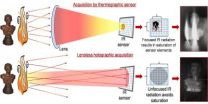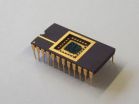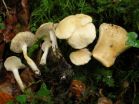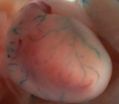(Press-News.org) Firefighters put their lives on the line in some of the most dangerous conditions on Earth. One of their greatest challenges, however, is seeing through thick veils of smoke and walls of flame to find people in need of rescue. A team of Italian researchers has developed a new imaging technique that uses infrared (IR) digital holography to peer through chaotic conflagrations and capture potentially lifesaving and otherwise hidden details. The team describes its breakthrough results and their applications in a paper published today in the Optical Society's (OSA) open-access journal Optics Express.
Firefighters can see through smoke using current IR camera technology. However, such instruments are blinded by the intense infrared radiation emitted by flames, which overwhelm the sensitive detectors and limit their use in the field. By employing a specialized lens-free technique, the researchers have created a system that is able to cope with the flood of radiation from an environment filled with flames as well as smoke.
"IR cameras cannot 'see' objects or humans behind flames because of the need for a zoom lens that concentrates the rays on the sensor to form the image," says Pietro Ferraro of the Consiglio Nazionale delle Ricerche (CNR) Istituto Nazionale di Ottica in Italy. By eliminating the need for the zoom lens, the new technique avoids this drawback.
"It became clear to us that we had in our hands a technology that could be exploited by emergency responders and firefighters at a fire scene to see through smoke without being blinded by flames, a limitation of existing technology," Ferraro says. "Perhaps most importantly, we demonstrated for the first time that a holographic recording of a live person can be achieved even while the body is moving."
Holography is a means of producing a 3-D image of an object. To create a hologram, such as those typically seen on credit cards, a laser beam is split into two (an object beam and a reference beam). The object beam is shone onto the object being imaged. When the reflected object beam and the reference beam are recombined, they create an interference pattern that encodes the 3-D image.
VIDEO:
A side-by-side comparison of a traditional imaging system, in which the view of a man is obstructed by flames, and the new technique, in which the viewer can see the...
Click here for more information.
In the researchers' new imaging system, a beam of infrared laser light is widely dispersed throughout a room. Unlike visible light, which cannot penetrate thick smoke and flames, the IR rays pass through largely unhindered. The IR light does, however, reflect off of any objects or people in the room, and the information carried by this reflected light is recorded by a holographic imager. It is then decoded to reveal the objects beyond the smoke and flames. The result is a live, 3-D movie of the room and its contents.
The next step in moving this technology to the field is to develop a portable tripod-based system that houses both the laser source and the IR camera. The systems may also be suitable for fixed installation inside buildings or tunnels. In addition, the team is exploring other applications, most notably in the biomedical field for non-destructive testing of large aerospace composite structures.
"Besides life-saving applications in fire and rescue, the potential to record dynamic scenes of a human body could have a variety of other biomedical uses including studying or monitoring breathing, cardiac beat detection and analysis, or measurement of body deformation due to various stresses during exercise," Ferraro says. "We are excited to further develop this technology and realize its application for saving and improving human life."
INFORMATION:
Paper: "Imaging live humans through smoke and flames using far-infrared digital holography," M. Locatelli et al., Optics Express, Vol. 21, Issue 5, pp. 5379-5390 (2013) (link: http://www.opticsinfobase.org/oe/abstract.cfm?uri=oe-21-5-5379).
EDITOR'S NOTE: Images and a movie of the new technique are available to members of the media upon request. Contact Angela Stark.
About Optics Express
Optics Express reports on new developments in all fields of optical science and technology every two weeks. The journal provides rapid publication of original, peer-reviewed papers. It is published by the Optical Society and edited by Andrew M. Weiner of Purdue University. Optics Express is an open-access journal and is available at no cost to readers online at www.OpticsInfoBase.org/OE.
About OSA
Uniting more than 180,000 professionals from 175 countries, the Optical Society (OSA) brings together the global optics community through its programs and initiatives. Since 1916 OSA has worked to advance the common interests of the field, providing educational resources to the scientists, engineers and business leaders who work in the field by promoting the science of light and the advanced technologies made possible by optics and photonics. OSA publications, events, technical groups and programs foster optics knowledge and scientific collaboration among all those with an interest in optics and photonics. For more information, visit www.osa.org.
Infrared digital holography allows firefighters to see through flames, image moving people
Other applications could include monitoring breathing, cardiac beat detection and analysis, body deformation measurements during exercise
2013-02-26
ELSE PRESS RELEASES FROM THIS DATE:
Sweet news for stem cell's 'Holy Grail'
2013-02-26
Scientists have used sugar-coated scaffolding to move a step closer to the routine use of stem cells in the clinic and unlock their huge potential to cure diseases from Alzheimer's to diabetes.
Stem cells have the unique ability to turn into any type of human cell, opening up all sorts of therapeutic possibilities for some of the world's incurable diseases and conditions.
The problem facing scientists is how to encourage stem cells to turn into the particular type of cell required to treat a specific disease.
But researchers at the University of Manchester's School ...
A picture of health in schools
2013-02-26
Feeling comfortable and confident in sport, health, or PE can be very difficult for some young people who can be seen as a 'risk' of becoming obese. Young people from ethnic minorities, especially girls, are more likely to be physically inactive and unhealthy.
This perception needs to be addressed and challenged in school physical education (PE) according to research funded by the Economic and Social Research Council (ESRC), which shows how school provision could make use of visual approaches in developing young people's critical learning about the body.
When Dr Laura ...
Blueprint for an artificial brain
2013-02-26
This press release is available in German.
Scientists have long been dreaming about building a computer that would work like a brain. This is because a brain is far more energy-saving than a computer, it can learn by itself, and it doesn't need any programming. Privatdozent [senior lecturer] Dr. Andy Thomas from Bielefeld University's Faculty of Physics is experimenting with memristors – electronic microcomponents that imitate natural nerves. Thomas and his colleagues proved that they could do this a year ago. They constructed a memristor that is capable of learning. ...
2 new species of mushroom documented in the Iberian Peninsula
2013-02-26
In collaboration with the Royal Botanic Gardens of Madrid and the Slovenian Forestry Institute, researchers in the Basque Country have documented two new species of Hydnum, commonly known as ox tongue mushrooms, as part of their study published in the 'Mycologia' journal. This genus is known because many of its fungi are edible.
Spanish researchers have headed the discovery of two mushroom species belonging to the Hydnum genus, a type of fungus commonly used in cooking.
"During our study we discovered two new species: Hydnum ovoideisporum and Hydnum vesterholtii, which ...
EARTH: Setting sail on unknown seas
2013-02-26
Alexandria, VA – On June 5, 2012, a massive dock made landfall on Oregon's Agate Beach, just north of Newport. The dock carried with it a host of castaways, including as many as a hundred species of mollusks, anemones, sponges, oysters, crabs, barnacles, worms, sea stars, mussels and sea urchins. A placard on the side written in Japanese revealed that the dock had been unmoored from the Japanese coastal city of Misawa during the catastrophic tsunami on March 11, 2011, bringing with it an essentially intact subtidal community of Asian species to the Pacific Northwest. Although ...
Pain can be a relief
2013-02-26
If you accidently kick your toe against a doorframe you are probably going to find it very painful. As a purely intellectual experiment, imagine purposefully kicking a doorframe hard enough to potentially break your toe. When it turns out your toe has been battered but not broken, the pain may be interpreted more as a relief.
"It is not hard to understand that pain can be interpreted as less severe when an individual is aware that it could have been much more painful. Less expected, however, is the discovery that pain may be experienced as pleasant if something worse ...
When morning sickness lasts all day
2013-02-26
Almost all women experience some nausea or vomiting when pregnant. Approximately one out of every hundred suffers from acute nausea during pregnancy (hyperemesis gravidarum) and may need hospital treatment to restore hydration, electrolytes and vitamins intravenously.
"At worst, women may die if they go untreated. Many women find that the condition has an adverse effect on their work and family lives," states Åse Vikanes, senior researcher at the Norwegian Institute of Public Health and specialist in gynaecology and obstetrics.
Making up for insufficient research activity ...
Blood vessels 'sniff' gut microbes to regulate blood pressure
2013-02-26
Researchers at The Johns Hopkins University and Yale University have discovered that a specialized receptor, normally found in the nose, is also in blood vessels throughout the body, sensing small molecules created by microbes that line mammalian intestines, and responding to these molecules by increasing blood pressure. The finding suggests that gut bacteria are an integral part of the body's complex system for maintaining a stable blood pressure.
A description of the research, conducted in mice and test tubes, appeared online Feb. 11 in the journal Proceedings of the ...
Cell discovery could hold key to causes of inherited diseases
2013-02-26
Fresh insights into the protective seal that surrounds the DNA of our cells could help develop treatments for inherited muscle, brain, bone and skin disorders.
Researchers have discovered that the proteins within this coating – known as the nuclear envelope – vary greatly between cells in different organs of the body.
This variation means that certain disease causing proteins will interact with the proteins in the protective seal to cause illness in some organs, but not others.
Until now scientists had thought that all proteins within the nuclear envelope were the ...
Afterschool programs evaluated for community support, resources
2013-02-26
UNIVERSITY PARK, Pa. -- Afterschool programs seem to be most effective when their organization and implementation is supported by both organizational and community resources, according to Penn State human development researchers.
Using a tool to help bridge the gap between research and real life, the researchers evaluated an afterschool program called the Good Behavior Game.
"The Interactive System Framework for Dissemination and Implementation is the tool that helps us to bridge research and practice by synthesizing the available research and figuring out what it ...
LAST 30 PRESS RELEASES:
Scalable and healable gradient textiles for multi‑scenario radiative cooling via bicomponent blow spinning
Research shows informed traders never let a good climate crisis go to waste
Intelligent XGBoost framework enhances asphalt pavement skid resistance assessment
Dual-function biomaterials for postoperative osteosarcoma: Tumor suppression and bone regeneration
New framework reveals where transport emissions concentrate in Singapore
NTP-enhanced lattice oxygen activation in Ce-Co catalysts for low-temperature soot combustion
Synergistic interface engineering in Cu-Zn-Ce catalysts for efficient CO2 hydrogenation to methanol
COVID-19 leaves a lasting mark on the human brain
Scientists use ultrasound to soften and treat cancer tumors without damaging healthy tissue
Community swimming program for Black youth boosts skills, sense of belonging, study finds
Specific depressive symptoms in midlife linked to increased dementia risk
An ‘illuminating’ design sheds light on cholesterol
Who is more likely to get long COVID?
Study showcases resilience and rapid growth of “living rocks”
Naval Research Lab diver earns Office of Naval Research 2025 Sailor of the Year
New Mayo-led study establishes practical definition for rapidly progressive dementia
Fossil fuel industry’s “climate false solutions” reinforce its power and aggravate environmental injustice
Researchers reveal bias in a widely used measure of algorithm performance
Alcohol causes cancer. A study from IOCB Prague confirms damage to DNA and shows how cells defend against it
Hidden viruses in wastewater treatment may shape public health risks, study finds
Unlock the power of nature: how biomass can transform climate mitigation
Biochar reshapes hidden soil microbes that capture carbon dioxide in farmland
Reducing saturated fat intake shows mortality benefit, but only in high-risk individuals
Manta rays create mobile ecosystems, study finds
Study: Mixed results in using lipoic acid to treat progressive multiple sclerosis
Norbert Holtkamp appointed director of Fermi National Accelerator Laboratory
New agentic AI platform accelerates advanced optics design
Biologists discover neurons use physical signals — not electricity — to stabilize communication
Researchers discover that a hormone can access the brain by hitchhiking
University of Oklahoma researcher awarded funding to pursue AI-powered material design
[Press-News.org] Infrared digital holography allows firefighters to see through flames, image moving peopleOther applications could include monitoring breathing, cardiac beat detection and analysis, body deformation measurements during exercise



